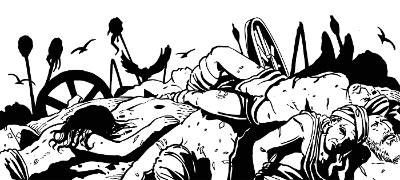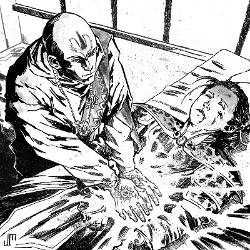Injury: Damage and Healing

Damage
Damage may be inflicted by physical or magical attacks, accidental injury, disease, or environmental stress. A character's ability to survive damage is quantified by Secondary Stat, Hit Points. Damage sustained reduces Hit Points from their maximum, healthy value. When a character's current Hit Point total is reduced to or below 0, he is incapacitated and probably dying.
Calculating Damage
Damage from physical attacks is determined by rolling the Damage die for the weapon used in the attack. The attacker applies any Damage adjustments to the value rolled to find the damage inflicted. Then the defender applies any Armor or other adjustments to the damage inflicted to determine the amount of damage sustained, and deducts that amount from his current Hit Points.
Damage from other sources—such as magical effects, accidental injury, disease or distress—is calculated according to the rules for that damage source.
Injury Status
There are five statuses, based on current Hit Points:
- Healthy: Current HP = maxHP
- Bruised: Current HP >= half of maxHP
- Wounded: Current HP >= 1
- Incapacitated: Current HP <= 0; Character is unconscious, and may not move or act in any way
- Dead: Current HP <= 0 - maxHP; Character may not be healed by any means short of resurrection
Stunning Blows
Any attack or injury in which a character sustains damage in excess of one half of his maximum Hit Point value is considered a stunning blow, and may cause that character to be stunned. He may avoid being stunned by immediately making a Brawn or Nerve Check against a Challenge Rating (CR) equal to the amount of damage taken from the injury.
A stunned character may not move or take any action on his own. He makes no Defense Check when attacked—anyone attacking a stunned character makes an Easy Attack Check (CR 6) to hit. A stunned character may be guided by an ally to sit, lie prone, or walk at a rate of 1 space per Round. Guiding a stunned character is a special action costing the guide 1 AP per instruction ("sit," "lie down," or "take a step").
A stunned character makes a Recovery Check using Brawn or Nerve during the reset phase of each turn. The CR for this Check is equal to the amount of damage taken in the attack that originally stunned the character. Once the character succeeds at a Recovery Check, the stunned condition is removed. The character resets his Action Points and Free Steps in that reset phase, and may act normally in the action phase of the next turn.
Dying from Injuries
A character whose Hit Points have been reduced to or below 0 is dying. He will continue to lose 1 HP per turn (not per round) until his current Hit Points reach the inverse of his maximum Hit Point value (0 - maxHP), at which point he becomes dead.
A dying person may be stabilized to stop the continuing loss of Hit Points. Any successful healing spell cast upon the dying character automatically stabilizes his condition, so he is no longer dying. Stabilizing a dying character with conventional first aid requires a successful Healing Check.
Once stabilized, the injured character remains incapacitated until his Hit Points are restored to 1 HP or greater.

Healing
Injured characters may recover lost Hit Points through various types of healing.
First Aid
Stabilizing bleeding characters
The Healing skill may be used to stabilize a bleeding or dying character, removing the adverse condition and stopping further loss of Hit Points. In combat, Administer first aid is an Action requiring a full Round to perform, with an AP cost of 3/Only. Healing applied in combat only stops Hit Point loss due to a bleeding or dying condition; it does not restore any of the lost HP. To stabilize a bleeding or dying character, the character administering first aid must succeed on a Healing Check; stabilizing a bruised character is an Easy Challenge (CR 6), while stabilizing a wounded or incapacitated character is a Moderate Challenge (CR 9).
The same healer may make repeated attempts to stabilize a bleeding or dying character, until success is achieved or the wounded character dies. A bleeding character who is conscious may attempt to stop his own bleeding; this is a Moderate Challenge (CR 9) for a bruised character, or Hard (CR 12) if he's wounded. An incapacitated character is unconscious, and cannot attempt to stabilize himself.
Binding wounds
Immediately after combat or other injury, the Healing skill may be used to bind wounds suffered by an injured character, restoring a small number of Hit Points lost due to injury in the just-completed encounter. Binding the wounds of a bruised character is an Easy Challenge (CR 6) using the Healing skill, restoring 1 lost HP. Binding the wounds of a wounded or incapacitated character is a Moderate Challenge (CR 9), restoring 2 lost HP. Binding the wounds of an injured character takes several minutes of relative calm, requires first aid supplies including bandages, and must be done no more than 30 minutes after the injury was sustained.
An injured character may attempt to bind his own wounds using the Healing skill; this is a Moderate Challenge (CR 9) if he is bruised, or Hard (CR 9) if he is wounded. When binding wounds, only one Healing Check is allowed; repeated attempts, by the same healer or multiple healers, have no effect.
Amateur First Aid
Characters without the Healing skill may attempt to stabilize a character or bind his wounds, making a basic Savvy Check with a penalty adjustment of -2.
Magical Healing
Injured characters may also be healed by healing magic in the form of spells, rituals, potions, or artifacts. The mechanics of magical healing vary, and are detailed in the rules for the specific spell or other means of healing.
Rest and Recuperation
After the wounds of an injured character have been bound, unless restorative magic is available, time and rest are the best source of healing. Once every 24 hours, an injured character makes a Recuperation Check, using Brawn or Nerve, in a scaling challenge, with each rank of success restoring one Hit Point. The challenge rating for the Check varies according to the hero's circumstances:
| Recuperation Table | |
|---|---|
| Circumstances of Recuperation | Challenge |
| Resting under comfortable conditions, such as a well-run hospital or upper-class home | Easy (CR 6) |
| Resting under imperfect conditions, such as a field hospital or middle-class home | Moderate (CR 9) |
| Resting under difficult conditions, such as a badly-run hospital or improvised shelter | Hard (CR 12) |
| Prevented from resting at all, perhaps fleeing pursuit or being forced into physical labor | Heroic (CR 15) |
A competent caregiver can improve the rate of recovery by succeeding at a Healing Check against a scaling challenge. The base CR for the check is determined by the patient's current status. For each rank of success the caregiver achieves on his Healing check, the patient gets a +1 Adjustment to his Recuperation check.
| Caregiver's Effect Table | |
|---|---|
| Status of Patient | Challenge |
| Bruised | Easy (CR 6) |
| Bloodied | Moderate (CR 9) |
| Incapacitated | Hard (CR 12) |